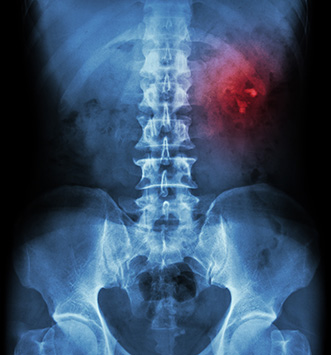Kidney stones affect men (1 in 8) more often than women (1 in 20)
According to some estimates, 25 million men and women will develop a kidney stone during their lifetime. Furthermore, after the first stone episode, the likelihood of forming another stone is 50% within five years, and 80% over a lifetime. Fortunately, preventive measures discussed below lower this risk to 10% or less.
Kidney Stones (also called calculi) are crystalline aggregates of waste material that form in urine. Urine is the end result of a continuous filtration process that takes place in our kidneys. Every twenty-four hours the kidneys filter over 100 gallons of blood and excrete (get rid of) excess water, electrolytes, and waste material. This finely tuned filtration process helps the body maintain proper fluid, electrolyte, and pH balance.

Stones form when the concentration of crystal-forming substances such as calcium, oxalate, and uric acid exceed the ability of the urine to keep them dissolved. This usually happens when urinary output is too low and the urine becomes concentrated. Instead of staying in solution, crystals clump together and form crystal aggregates. This “gravel” starts in tubules called collecting tubules. These tubules transport filtered urine into the collecting system of the kidney (called the renal calyces and pelvis). If the crystals are small enough, and the urinary flow is sufficient, they get washed out without causing any problems. However, if the crystals aren’t flushed out, they accumulate more crystals, continue to grow, and become stones. (Another name for a kidney stone is a calculus, or calculi if there is more than one stone.)
When kidney stones migrate into the ureter – the tube leading from the kidney to the bladder – they’re called ureteral stones. They’re still the same stone, just in a different location. Therefore the following discussion applies for both kidney and ureteral stones.
What causes kidney stones?
The following factors increase the risk of stone formation:
- Genetics: Twenty-five percent of stone formers have a family history of stone disease. The following conditions deserve special mention: renal tubular acidosis is an inherited condition characterized by alkaline urine. The kidneys are unable to acidify urine below a pH of 6 (normally, the kidneys can acidify the urine to a pH of 5). Acid urine has a pH below 7, and alkaline urine is any pH above 7. Alkaline urine increases the formation of calcium oxalate stones. Cysteinuria is another inherited condition. The kidneys are unable to excrete cysteine and three other amino acids derived from protein metabolism. Consequently cysteine accumulates in the urine and forms stones.
- Diet: As a general rule, excess salt, protein, sugar, and oxalate intake coupled with a low fluid consumption increases the risk of stone formation (see a detailed discussion under prevention). Crash diets also increase the risk of stone disease. Sudden weight loss burns fat and releases a flood of waste metabolites that must be filtered and excreted in the urine. These waste products cause the urine to become acidic. Acid urine increases stone formation (see the discussion below about prevention of calcium oxalate stones).
Anatomic abnormalities: Structural abnormalities in the urinary tract that cause urine to stagnate increase the risk of stone formation. - Urinary tract infections: Certain types of urinary tract infections increase the risk of stones. Urease-producing bacteria (e.g., proteus, pseudomonas, and klebsiella species) metabolize a substance called urea, which causes the urine to become extremely alkaline. Persistently alkaline urine causes a conglomeration of magnesium, ammonium, and phosphate (struvite) crystals that bind with calcium phosphate to form “triple phosphate” stones.
- Occupation: Dehydration increases the risk of stone formation. People that work in jobs that entail a lot of sweating, or jobs that make frequent trips to the bathroom problematic (e.g., pilots, teachers, truck drivers) often fail to drink enough water.
- Lifestyle: Stones often occur during summer months, or when people vacation in a sunny climate. Sun exposure increases vitamin D production, which increases intestinal calcium absorption. Furthermore, sweating, excess alcohol consumption, and inadequate fluid intake collectively increase stone formation because they cause dehydration. The final whammy is a “I’m on vacation” diet that is chock full of fat, sugar, salt, excess protein. As you’ll soon learn, these three items conspire to make stones more likely.
- Medications: Certain medications, for instance Diamox®, a medication used to treat glaucoma, increase the risk of stones because it increases calcium excretion, but inhibits citrate excretion (a chemical excreted in the urine that prevents stone formation).
